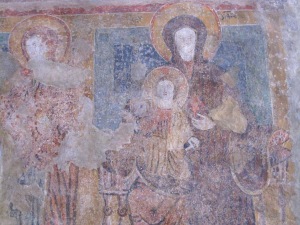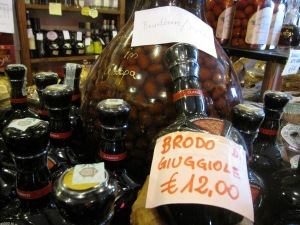Clockwise: the entrance to Petrarch’s home; 13th century Venetian school fresco inside the Santa Maria church; Petrarch’s tomb; pomegranates growing on a roadside tree
Se ti agita sacro amore di Patria, t’inchina a queste mura ove spirò la grande anima il cantor dei Scipioni e di Laura. If you are moved by the sacred love of country, bow down before this wall where a great soul, the singer of Scipio and of Laura passed away.
-Inscription at the house of Petrarch
One of the best parts about living in Italy is that the country has immense historical and cultural wealth, simply by virtue of having advanced civilizations living here for eons. You can drive into almost any random small town in Italy and discover a Baroque church, a medieval castle, a Renaissance marble sculpture…try doing that in the United States and you’ll find a McDonald’s parking lot. Thus, I am often afflicted with country-envy when I speak to Italians, who don’t even bat an eye as they point out the astronomy tower that Galileo conducted research in, while my jaw drops in excitement. On the other hand, the other day I started grilling Valeria on the history of the Italian republic and it went something like this:
V: You know how every other street is named Garibaldi? That’s because Giuseppe Garibaldi was the one who led the drive for the unification of Italy in 1861.
Me: Oh, 1861? To me, that year signifies the start of the American Civil War. Wait a minute, modern Italy was founded in 1861? Then I shouldn’t feel bad, my country is older than yours after all!
V: …I guess you could look at it that way.
Rivalries aside, Valeria was kind enough to act as a guide and host her flatmates in Veneto for a few days. Veneto is a region in northeast Italy, where Valeria and several previous generations of her family grew up. It is most famous for the canal-lined city of Venice, but we were taking some time to explore the Colli Euganei (Euganean Hills), known for being a center of moscato wines. We wandered through Monselice and Este, paused to ogle at the castles, and eventually made our way to Arqua Petrarca, so named because it is the deathplace of Petrarch.
Petrarch is a 14th century Italian Renaissance scholar, best known for his poetry. “Every Italian student knows about Petrarch and his love for Laura,” said Valeria. “He loved her but his was an unrequited love, and then she died and he went off to become a priest.” Sad trombone. We gazed at Petrarch’s tomb, a massive sepulcher of pink Verona marble, where the poet was buried according to his wishes. Over the centuries, his remains have been raided by zealous Petrarch fans and also exhumed several times by researchers trying to determine whether they are indeed genuine. To the best of our knowledge, the remains really are from Petrarch, and the skeleton shows indications of injuries present in Petrarch’s writings, like a kick from a donkey when he was 42.
If you wander up the hill, you can see Petrarch’s house, which has been preserved and converted into a museum. Admission is €4/2 students. Petrarch lived here until his death from 1370-74, and the building currently houses an exhibit on his works, life and relics. Reading the timeline of his life, I was surprised to discover that far from pining over Laura for the rest of his life, the bulk of Petrarch’s scholarly and literary accomplishments actually happened after her death. Besides, he didn’t encounter Laura more than once or twice, probably never spoke to her, and subsequently fathered two children by different women in later years. So, why does everyone hold his love for Laura in such reverence? “Well, love was treated a little differently back then,” said Valeria. “He probably needed a feminine ideal, a muse, a female figure to write about, and Laura was his chosen woman. It’s nothing like the modern day treatment of love.” Hmm, and my mother always tells me that it is better to embrace the old-fashioned concept of love!
Clockwise: bottles of brodo di giuggiole (jujube) liqueur; grappa and wine bottles line the shelves of Enoteca Il Giuggiolo; wine list at Osteria Al Guerriero; decorative grappa infused with juniper
Let’s not forget the real reason we are here though: the booze. Colli Euganei is a land of fine vineyards, the most prominent being Ca’Orologio and La Montecchia. In this region, you will find cabernet franc, merlot and cabernet sauvignon, but the real local gems are the pinello, fior d’arancio and serprino wines, which are only available in Colli Euganei. In addition, Arqua Petrarca is known for its production of brodo di giuggiole, or jujube liqueur, and incorporates the jujube fruit in all sorts of cookies, tarts and alcoholic products.
We stopped by Enoteca Il Giuggiole, where you can sample the brodo di giuggiole. It is fruity but not too sweet, and can be used as a digestif or in mixed drinks. The fresh fruit has a large pit wrapped inside firm, crisp flesh that tastes like a date. The enoteca does not provide wine samples, but the selection is all good and most bottles are under €10. In the name of Research, I picked up a bottle of La Montecchia’s Godimondo cabernet franc and Villa Sceriman’s Colli Euganei serprino. Then we went down the street to Osteria Al Guerriero for a glass of serprino. Clean, delicate, a cousin to prosecco, I sipped my wine and mused about hopeless infatuations.







